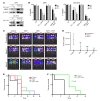Destabilizing NEK2 overcomes resistance to proteasome inhibition in multiple myeloma
- PMID: 29863498
- PMCID: PMC6026005
- DOI: 10.1172/JCI98765
Destabilizing NEK2 overcomes resistance to proteasome inhibition in multiple myeloma
Abstract
Drug resistance remains the key problem in cancer treatment. It is now accepted that each myeloma patient harbors multiple subclones and subclone dominance may change over time. The coexistence of multiple subclones with high or low chromosomal instability (CIN) signature causes heterogeneity and drug resistance with consequent disease relapse. In this study, using a tandem affinity purification-mass spectrometry (TAP-MS) technique, we found that NEK2, a CIN gene, was bound to the deubiquitinase USP7. Binding to USP7 prevented NEK2 ubiquitination resulting in NEK2 stabilization. Increased NEK2 kinase levels activated the canonical NF-κB signaling pathway through the PP1α/AKT axis. Newly diagnosed myeloma patients with activated NF-κB signaling through increased NEK2 activity had poorer event-free and overall survivals based on multiple independent clinical cohorts. We also found that NEK2 activated heparanase, a secreted enzyme, responsible for bone destruction in an NF-κB-dependent manner. Intriguingly, both NEK2 and USP7 inhibitors showed great efficacy in inhibiting myeloma cell growth and overcoming NEK2-induced and -acquired drug resistance in xenograft myeloma mouse models.
Keywords: B cells; Cancer; Oncology.
Conflict of interest statement
Figures











Similar articles
-
Blockade of deubiquitinase USP7 overcomes bortezomib resistance by suppressing NF-κB signaling pathway in multiple myeloma.J Leukoc Biol. 2018 Dec;104(6):1105-1115. doi: 10.1002/JLB.2A1017-420RR. Epub 2018 Jul 19. J Leukoc Biol. 2018. PMID: 30024656
-
Indirubin-3'-monoxime acts as proteasome inhibitor: Therapeutic application in multiple myeloma.EBioMedicine. 2022 Apr;78:103950. doi: 10.1016/j.ebiom.2022.103950. Epub 2022 Mar 26. EBioMedicine. 2022. PMID: 35344764 Free PMC article.
-
NEK2 induces autophagy-mediated bortezomib resistance by stabilizing Beclin-1 in multiple myeloma.Mol Oncol. 2020 Apr;14(4):763-778. doi: 10.1002/1878-0261.12641. Epub 2020 Jan 29. Mol Oncol. 2020. PMID: 31955515 Free PMC article.
-
Proteasome inhibitor therapy in multiple myeloma.Mol Cancer Ther. 2005 Apr;4(4):686-92. doi: 10.1158/1535-7163.MCT-04-0338. Mol Cancer Ther. 2005. PMID: 15827343 Review.
-
The proteasome and proteasome inhibitors in multiple myeloma.Cancer Metastasis Rev. 2017 Dec;36(4):561-584. doi: 10.1007/s10555-017-9707-8. Cancer Metastasis Rev. 2017. PMID: 29196868 Review.
Cited by
-
DNp73 enhances tumor progression and immune evasion in multiple myeloma by targeting the MYC and MYCN pathways.Front Immunol. 2024 Sep 24;15:1470328. doi: 10.3389/fimmu.2024.1470328. eCollection 2024. Front Immunol. 2024. PMID: 39380995 Free PMC article.
-
The Evidence That 25(OH)D3 and VK2 MK-7 Vitamins Influence the Proliferative Potential and Gene Expression Profiles of Multiple Myeloma Cells and the Development of Resistance to Bortezomib.Nutrients. 2022 Dec 6;14(23):5190. doi: 10.3390/nu14235190. Nutrients. 2022. PMID: 36501221 Free PMC article.
-
NEK2 promotes the migration and proliferation of ESCC via stabilization of YAP1 by phosphorylation at Thr-143.Cell Commun Signal. 2022 Jun 15;20(1):87. doi: 10.1186/s12964-022-00898-0. Cell Commun Signal. 2022. PMID: 35705994 Free PMC article.
-
Nuclear deubiquitination in the spotlight: the multifaceted nature of USP7 biology in disease.Curr Opin Cell Biol. 2019 Jun;58:85-94. doi: 10.1016/j.ceb.2019.02.008. Epub 2019 Mar 18. Curr Opin Cell Biol. 2019. PMID: 30897496 Free PMC article. Review.
-
Troponin T1 in tumorigenesis and immune modulation: Insights into multiple cancers and kidney renal clear cell carcinoma.J Cell Mol Med. 2024 Jun;28(11):e18410. doi: 10.1111/jcmm.18410. J Cell Mol Med. 2024. PMID: 38853457 Free PMC article.
References
Publication types
MeSH terms
Substances
Grants and funding
LinkOut - more resources
Full Text Sources
Other Literature Sources
Medical
Research Materials
Miscellaneous

